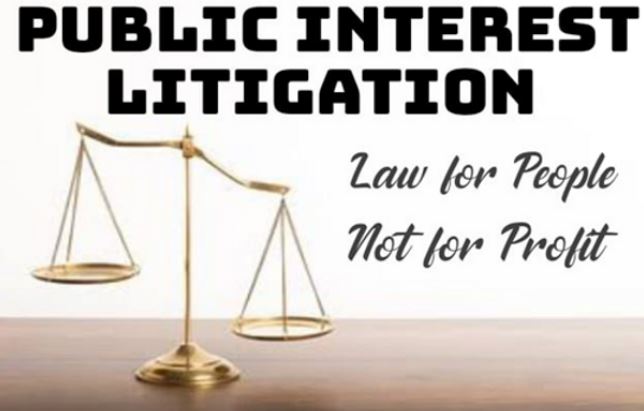An Examination into the Concept and Theory of Public Interest Litigation (2011)
Initially Public interest litigation was considered as a strategy to enable public spirited citizens and social activists to mobilize favourable judicial concern on behalf of the victimised and oppressed groups. It has become today a powerful weapon of the judicial activism for involvement in social political and economic affairs of the society. Judiciary, being the sentinel of constitutional statutory rights of citizens has a special role to play in the constitutional scheme.
It can review legislation and administrative actions or decisions on the anvil of constitutional law. For the enforcement of fundamental rights one has to move the Supreme Court or the High Courts directly by invoking Writ Jurisdiction of these courts. But the high cost and complicated procedure involved in litigation, however, makes equal access to jurisdiction in mere slogan in respect of millions of destitute and underprivileged masses stricken by poverty, illiteracy and ignorance. The Supreme Court of India pioneered the Public Interest Litigation (PIL) thereby throwing upon the portals of courts to the common man.
Till 1960s and seventies, the concept of litigation in India was still in its rudimentary form and was seen as a private pursuit for the vindication of private vested interests. Litigation in those days consisted mainly of some action initiated and continued by certain individuals, usually, addressing their own grievances/problems. Thus, the initiation and continuance of litigation was the prerogative of the injured person or the aggrieved party. Even this was greatly limited by the resources available with those individuals.
There was very little organized efforts or attempts to take up wider issues that affected classes of consumers or the general public at large. However, these entire scenario changed during Eighties with the Supreme Court of India led the concept of public interest litigation (PIL). The Supreme Court of India gave all individuals in the country and the newly formed consumer groups or social action groups, an easier access to the law and introduced in their work a broad public interest perspective. Objectives of the study
1. To examine the concept and theory of Public Interest Litigation.
2. To evaluate the various Public interest litigations filed in the Supreme court and in the various High Courts in India.
3. To examine various writs, their roles and milestones of Public interest litigations in India.
4. To compare and analyse the Public interest litigations in Countries like USA , Malaysia & South Africa.
5. To study various judgments delivered in the Public interest litigations which are having great significance value.
6. To suggest certain suitable suggestions for avoiding the vexatious litigations filed under the veil of PILs.
- 50,000 words – 170 pages in length
- Extensive and outstanding use of literature
- Expertly written throughout
- Outstanding piece of work
- Ideal for law and international business students
1: Introduction
Meaning of Public Interest Litigation
Characteristics of Public Interest Litigation
Significance of the Topic
Objectives of the study
Review of literature
Historical development of the Writ of habeas corpus
When the Writ does not lie
Grounds of Habeas Corpus
Against whom writ of mandamus can be issued
Grounds of the Writ of Mandamus
Grounds on which writs of mandamus may be refused
Against whom a Writ of Mandamus cannot be issued
Writ of Mandamus overlaps Certiorari
Conditions for the issue of quo warranto
Conditions when writ of quo warranto will not lie
The scope and grounds for the issue of the writ of prohibition
Grounds of Writ of Prohibition
Distinction between the writ of certiorari and prohibition
Distinction between the writ of prohibition and mandamus
Against whom it can be issued
Who may apply for the writ of certiorari
Grounds of Writ of Certiorari
2: Origin and Development of PIL
Evolution of Public Interest Litigations
Legal History
Development of Public Interest Litigation in India
Subjects of Public Interest Litigation
The matters of public interest
The matters of private nature
Letter Petitions
Milestones of Public Interest Litigation in India
3:Concept and Theory of PIL
Conditions for Public Interest Litigation
Relevance of Public Interest Litigation
Locus Standi
When Can A PIL Be Filed
Who Can File A PIL
Against whom PIL can be filed
Aspects of PIL
Remedial in Nature
Representative Standing
Citizen standing
Non-adversarial Litigation
Collaborative litigation
Investigative Litigation
Crucial Aspects
Relaxation of strict rule of Locus Standi
Epistolary Jurisdiction
Factors that have contributed to growth of PIL
Mechanism for protection of Human Rights through PIL
Procedure for Filing PIL
4: Comparative analysis of PIL
Public Interest Litigation in United States
The theory and structure of public interest litigation
Public law litigation as a political practice
Public interest litigation in nations other than the U.S.
5: PIL and Judicial Activism in India
Judicial Activism
Ban on smoking in public places
Protection against inhuman treatment in jail
Child Welfare
Protection of Ecology and Environment Pollution
Professional ethics and Medical men
Handicapped to be given job opportunities
Power to commute death sentence into life imprisonment
Protection of dignity and honour of Courts
Rape on working women—Guidelines for rehabilitation and compensation
Direction for protection of women from prostitution and rehabilitation of their children
Proper Storage and Supply of Blood by Blood Banks
Power to award compensation under Article 32
Corruption in Public life and PIL
Electoral Reforms
People in Jail cannot contest Elections
Directions to make CBI independent and efficient
No court can stay proceedings under Prevention of Corruption Act
Central Bureau of Investigation (CBI) and Central Vigilance Commission (CVC)
Enforcement Directorate
Custodial Death
Protection from police atrocities
6: Conclusion and suggestions
Bibliography

